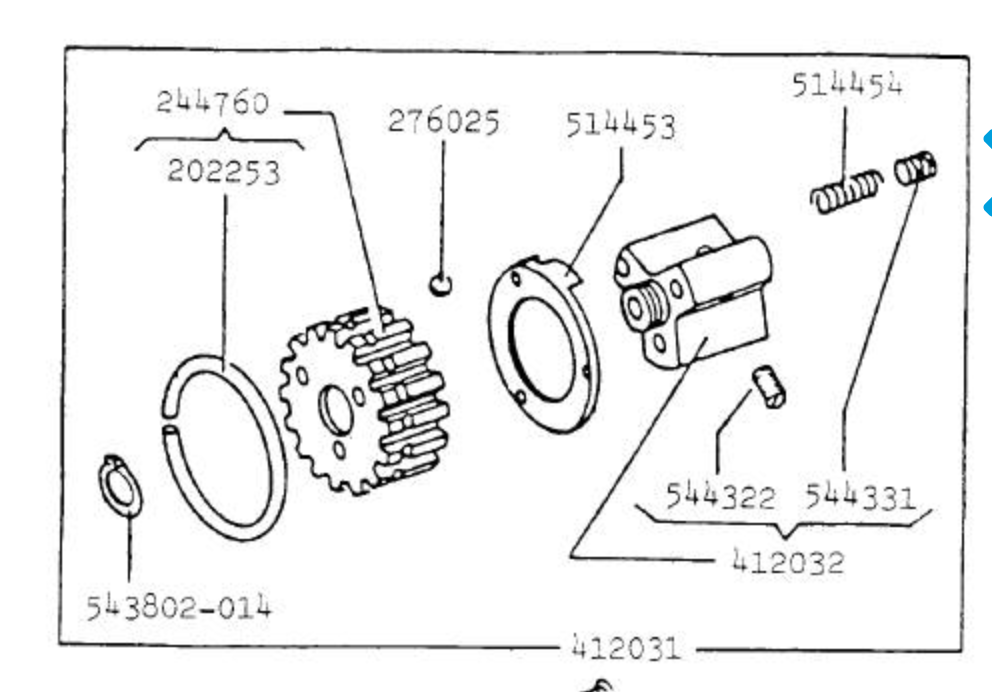-
Posts
420 -
Joined
-
Last visited
Content Type
Profiles
Forums
Events
Blogs
Gallery
Everything posted by friquant
-
The biggest issue going on is the top thread is not being pulled up all the way to form a tight stitch...rather, the loops of top thread are hanging free on the bottom. As kgg said, tighten the top thread tensioner, and if that does not clear it up, post photos of your top thread path so we can see if it is threaded correctly. The other issue is that it is skipping stitches. Here you will want to make friends with the service manual so you can set the hook to needle distance, the needle bar height, and the needle bar rise.
-

Singer 211 U166A walking foot problem
friquant replied to NowhereMan01's topic in Leather Sewing Machines
I believe you are on the right course. Here is a parts manual for a similar machine that seems helpful to understand the pieces: https://www.manualslib.com/manual/153942/Singer-211a165aa.html?page=15#manual The following page has descriptions of each part. The way I'm interpreting is that each of those three fat screws on the end has a spring underneath it. Together, those three screws through their respective springs provide pressure to the plate that has a detent for the ball. Someone may have screwed those adjusting screws all the way in, not knowing they were adjustment screws. -
Working great! Took some readjustment to get the hook stuffed again, but now it's stitching like a champ. Here is an example of the type of stitching that would make it skip like crazy before. That is, stitching a lump of foam where the foam is off-center and opposite the hook. (There is some play in the needle bar rock frame, that may be how it manages to stitch differently with different geometries under the presser feet.) But it nailed every stitch this time
-
I did get the hook back in the machine, but it's not adjusted yet. I need to bend the hook's needle guard so it doesn't protrude out so far, now that the hook has been filed. I have not figured out a good way to adjust needle guards. I've seen people use a screwdriver as a pry bar, pressing against the machine head. I've done that in the past, but it felt clunky. Not finding something good to press against today, so may need a custom tool. Or maybe pry against the feed dog support 🤷♂️ UPDATE: From the top side I was able to pry against the frame.
-
Here is the after photo: I can see now that the camera is not looking directly down the hook axis. Oh well..at least the before and after shots got the same treatment 🤷♂️ I faced the inside and outside edges of the hook using a diamond sharpening stone. Stone is 25x75x6 millimeters, on a 320mm stick of oak.
-
Considering that I couldn't find much for references, I agree that sharpening a hook is uncommon. I'm satisfied with the hook-to-needle timing, and I want a sharp hook with useful angles. So here we go... Here's the before photo, so you can see how rounded the tip of this hook is. Also note that the hook tip is positioned directly above the center of the hook in this photo, so you can imagine the arc swung by the hook as it intercepts the thread/needle.
-
Something that's new if you are coming from domestic sewing machines is that you have to hold the top thread when you start a seam. Here's what I do: Move the takeup lever to the highest position. (Otherwise the takeup lever will steal the top thread from you when you commence stitching) Insert material under presser foot Lower presser foot Hold top thread in place while you make your first two or three stitches, then you can release the top thread At the end of your seam, again move the takeup lever to the highest position to set the last stitch before you remove the material Sometimes instead of merely holding the top thread in place, I actually preload the top thread until the thread check spring deflects, then hold in that position to start the seam. If you choose to do this advanced option, because your middle presser has an open cutout on the right side you will need to have the top thread going down under your middle presser foot and out the the left. (My middle presser has a full round hole so I can pull mine any direction without deflecting the needle)
-
Do you have a manual? Here is one I found on manualslib: pfaff-491-471-manual.pdf Page 11-33 shows how to adjust the pressure of the roller presser. You may also want to check the height of the feed wheel, that's on page 11-18.
-

Singer 211 U166A walking foot problem
friquant replied to NowhereMan01's topic in Leather Sewing Machines
Closer, and much slower. 😉 With the machine moving at an even speed (a snail's pace) and never moving in reverse. And with the phone on its side (landscape) instead of up and down. Here is an example of close, slow videos from today: https://leatherworker.net/forum/topic/131845-pfaff-345-issues/ I agree with ALZilla. From your latest video, the hook is about 150 degrees ahead of where it should be. (Love those timing marks, so visible!) It would be ideal if you could master the art of tripping the safety clutch and then resetting it. Because there is no point in setting the hook timing unless the safety clutch has been re-engaged. While you're making friends with the safety clutch you could also adjust it so that it trips with less torque. That way you won't end up with the belt skipping time again the next time the hook gets bound up. "A" for persistence 🏆 -
Nice job on the videos! Adequately slow, in focus, and that second was such a CLOSEUP!!! 🤩 As the others have indicated, the hook timing needs to be retarded. In the first video, see the loop of thread that gets dragged around the bobbin the first time the hook grabs it? That loop is what gets pulled tight to form the next stitch, and the loop needs to be in front of the hook point in order to do so. Otherwise the hook will grab that loop on the hook's second time around and the machine will bind. To fix, you retard the hook timing until that loop is safely 5-10mm ahead of the hook point when the hook comes around the second time. (Or you can set the hook timing according to factory specs---that will probably accomplish the same goal.) 😀
-
I'd like to sharpen the hook on my Singer 144W103 in order to reduce skipped stitches. With the needle guard removed, the hook is barely close enough to graze the needle. But it's not the tip of the hook that strikes the needle. About 2mm back from the hook tip---that's the part of the hook that actually strikes the needle. I don't know if that means the hook is simply dull, or if it has been improperly sharpened in the past. When sharpening scissors, for example, the going strategy is to only grind on one face of the blade. So what are the rules of thumb for sharpening a hook? File one side, or both? What angle to use? Here are photos of the hook
-

Singer 211 U166A walking foot problem
friquant replied to NowhereMan01's topic in Leather Sewing Machines
You will want to get the correct set screw screwed into the groove in the shaft, as there are timing adjustments downstream of this that will be affected if this is incorrect. Typically there are two set screws, 90 degrees apart on the shaft. I can see the shaft has a groove in it. One of the set screws is meant to be tightened into the shaft groove (this screw often has a rounded tip that fits well into the groove). The other set screw is meant to be tightened against the regular face of the shaft. (this screw will likely have a flat tip) After you get that sorted, I would check that the clutch safety is engaged. And send us another video zoomed in on the needle and bobbin area, slow motion turn with the handwheel like four seconds or so per revolution. -

Singer 29k1 presser foot doesn't work
friquant replied to MelissaViarengo's topic in Leather Sewing Machines
I've never used a patcher. But I've read that these are fed only by the presser foot. Here are some questions for troubleshooting: How much pressure is the presser foot exerting on the fabric? (If it's not pressing hard enough it won't advance the fabric) With the needle removed and the presser foot up, how smooth is the throat plate? (Must be smooth in order for fabric to slide across it) Is there anything the fabric is catching on? You should be able to slide material across it easily with the presser foot up. What texture exists on the bottom of the presser foot? (Must have some texture to grab the fabric I think) Is the needle coming all the way out of the fabric before the presser foot moves? Good luck! -
This topic has inspired me to try stitching with larger cotton thread. I often use number 10 cotton yarn for practicing and prototyping, because I like the puffy look and it's available in bright colors. The next size up is "number 3", so I acquired a spool. Here is some number 3 cotton yarn ("natural" color) through the needle. The thread has a lineal weight of 360 mg/m, so it would be TEX 360 if you applied that scale. I used number 10 cotton yarn (black) in the bobbin, which weighs 170mg/m This is on a singer 144W103 with size 180 needle. Here is the number 3 yarn I bought: https://www.amazon.com/dp/B0BRLDP8CB
-
I'm finally living in a table, but still have to shuffle the motor out from behind the machine because I haven't got it mounted down below yet. I still make some adjustments/observations by squatting down to see from underneath. (The sheet metal drip pan / knee protector has been removed, otherwise I guess I'd need x-ray vision)
-

Singer 111w155 stitch length issues
friquant replied to Glaciersew's topic in Leather Sewing Machines
Looks like the belt is one tooth off. -

Singer 111w155 stitch length issues
friquant replied to Glaciersew's topic in Leather Sewing Machines
Feed timing looks good. The needle plate is loose, but I assume you knew that, and I don't think it will change the stitch length. -

Singer 211 U166A walking foot problem
friquant replied to NowhereMan01's topic in Leather Sewing Machines
Oh I see.. The feed eccentric slid about 1.25 inches to the right, exposing the actual cam lobe. Based on the manual page 24, "Feed Eccentric Adjustment", I think you are to slide the feed eccentric to the left so the cam lobe goes inside the pushrod, then apply your chosen amount of pressure to the left to compress the "feed driving eccentric adjusting disc spring" to achieve your chosen amount of spring pressure. Then tighten what appears to be set screws in the collar that holds the spring. -

Singer 111w155 stitch length issues
friquant replied to Glaciersew's topic in Leather Sewing Machines
I'm not able to view the videos. What format are they? Some people upload to youtube, the embed here. I find that too much work, so I shrink mine using ffmpeg (and convert to .mp4 along the way), then upload directly. -
They even match the paint job! 🤩 Does your machine have a piercer? That manual that Bob linked shows a piercer on page 22. I wondered what those are for..
-
This post is informative of the consew t1919 performance envelope:
-
Can you post photos of the thread path? What size and kind of thread are you using? What material are you stitching, and what size needle?
-

Pfaff 346-H2 won't pick up bobbin thread.
friquant replied to GPD's topic in Leather Sewing Machines
Aww well.. -

Frozen Stitch Length on Singer 144W103
friquant replied to friquant's topic in Leather Sewing Machines
I did buy some synthetic transmission oil. Somewhat surprised it's still red. 🍎 But it smells neutral. Actually even the diesel has not much smell when it's just a few drops. I'm not even doing it on the porch---too much strain. Just right in the living room, a couple drops of diesel and then shut the arm cap. Nobody has complained 😀



